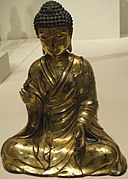
Liao dynasty
The Liao dynasty (/ljaʊ/;[3] Khitan: Mos Jælud; traditional Chinese: 遼朝; simplified Chinese: 辽朝; pinyin: Liáo cháo),[4] also known as the Khitan Empire (Khitan: Mos diau-d kitai huldʒi gur),[5] officially the Great Liao (Chinese: 大遼; pinyin: Dà Liáo), was an imperial dynasty of China that existed between 916 and 1125, ruled by the Yelü clan of the Khitan people. Founded around the time of the collapse of the Tang dynasty, at its greatest extent it ruled over Northeast China, the Mongolian Plateau, the northern part of the Korean Peninsula, southern portions of the Russian Far East, and the northern tip of the North China Plain.[6]
Great Liao / Khitan
Shangjing (Linhuang)1
907
916
947
1005
1114–1115
1124
1125
2,600,000 km2 (1,000,000 sq mi)
Mostly barter in the nomadic areas, and cash coins in the southern circuit. (See: Liao dynasty coinage)
The dynasty rose from the consolidation of power among the Khitans in the 8th century and their expansionist campaigns in the latter half of the 9th century. Eventually the Yila chieftain, Abaoji, became the leader of the Khitans and proclaimed a Chinese-style dynastic state in 916. The Liao dynasty launched multiple military campaigns against neighboring states and peoples including the Kumo Xi, Shiwei, Tatars, Zubu, Khongirad, Balhae, Goryeo, Later Tang, and the Song dynasty. Its conquests include the Sixteen Prefectures (including present-day Beijing and part of Hebei) by fueling a proxy war that led to the collapse of the Later Tang (923–936). In 1004, the Liao dynasty launched an expedition against the Northern Song dynasty. After heavy fighting and large casualties between the two empires, both sides worked out the Chanyuan Treaty. Through the treaty, the Liao dynasty forced the Northern Song to recognize them as peers and heralded an era of peace and stability between the two powers that lasted approximately 120 years. It was the first state to control all of Manchuria.[7]
Tension between traditional Khitan social and political practices and Han influence and customs was a defining feature of the dynasty. This tension led to a series of succession crises; Liao emperors favored the Han concept of primogeniture, while much of the rest of the Khitan elite supported the traditional method of succession by the strongest candidate. In addition, the adoption of Han systems and the push to reform Khitan practices led Abaoji to set up two parallel governments. The Northern Administration governed Khitan areas following traditional Khitan practices, while the Southern Administration governed areas with large non-Khitan populations, adopting traditional Han governmental practices.
The Liao dynasty was destroyed by the Jurchen-led Jin dynasty in 1125 with the capture of the Emperor Tianzuo of Liao. However, the remnant Liao loyalists, led by Yelü Dashi (Emperor Dezong of Liao), established the Western Liao dynasty (Qara Khitai), which ruled over parts of Central Asia for almost a century before being conquered by the Mongol Empire. Although cultural achievements associated with the Liao dynasty are considerable, and a number of various statuary and other artifacts exist in museums and other collections, major questions remain over the exact nature and extent of the influence of the Liao culture upon subsequent developments, such as the musical and theatrical arts.
Names[edit]
The "Great Khitan State" (Chinese: 大契丹; pinyin: Dà Qìdān) was founded in 907 by Abaoji (Emperor Taizu of Liao). In 947, Abaoji's successor, Emperor Taizong of Liao, officially renamed the dynasty as "Great Liao" (Chinese: 大遼; pinyin: Dà Liáo). This was probably due to the inclusion of non-Khitan peoples in the state. The name was changed back to "Great Khitan" in 983 during the reign of the Emperor Shengzong of Liao due to a reassertion of Khitan identity.[8] In 1066, Emperor Daozong of Liao reintroduced the dynastic name "Great Liao" and the title remained in official use until the dynasty's collapse. Both "Great Khitan" and "Great Liao" enjoyed about 100 years of usage each.[9]
In 1124, the successor state established by Yelü Dashi in the Western Regions also officially adopted the dynastic name "Great Liao". In historiography, however, this regime is more commonly called the "Western Liao" or "Qara Khitai". Due to the dominance of the Khitans during the Liao dynasty in Northeast China and Mongolia and later the Qara Khitai in Central Asia where they were seen as Chinese, the term "Khitai" came to mean "China" to people near them in Central Asia, Russia and northwestern China. The name was then introduced to medieval Europe via Islamic and Russian sources, and became "Cathay". In the modern era, words related to Khitay are still used as a name for China by Turkic peoples, such as the Uyghurs in China's Xinjiang region and the Kazakhs of Kazakhstan and areas adjoining it, and by some Slavic peoples, such as the Russians and Bulgarians.[10]
There is no consensus among historians regarding the etymology of "Liao". Some believe that "Liao" was derived from the word for "iron" in the Khitan language, while others believe that the name came from the Liao River catchment which was the traditional homeland of the Khitan people.




